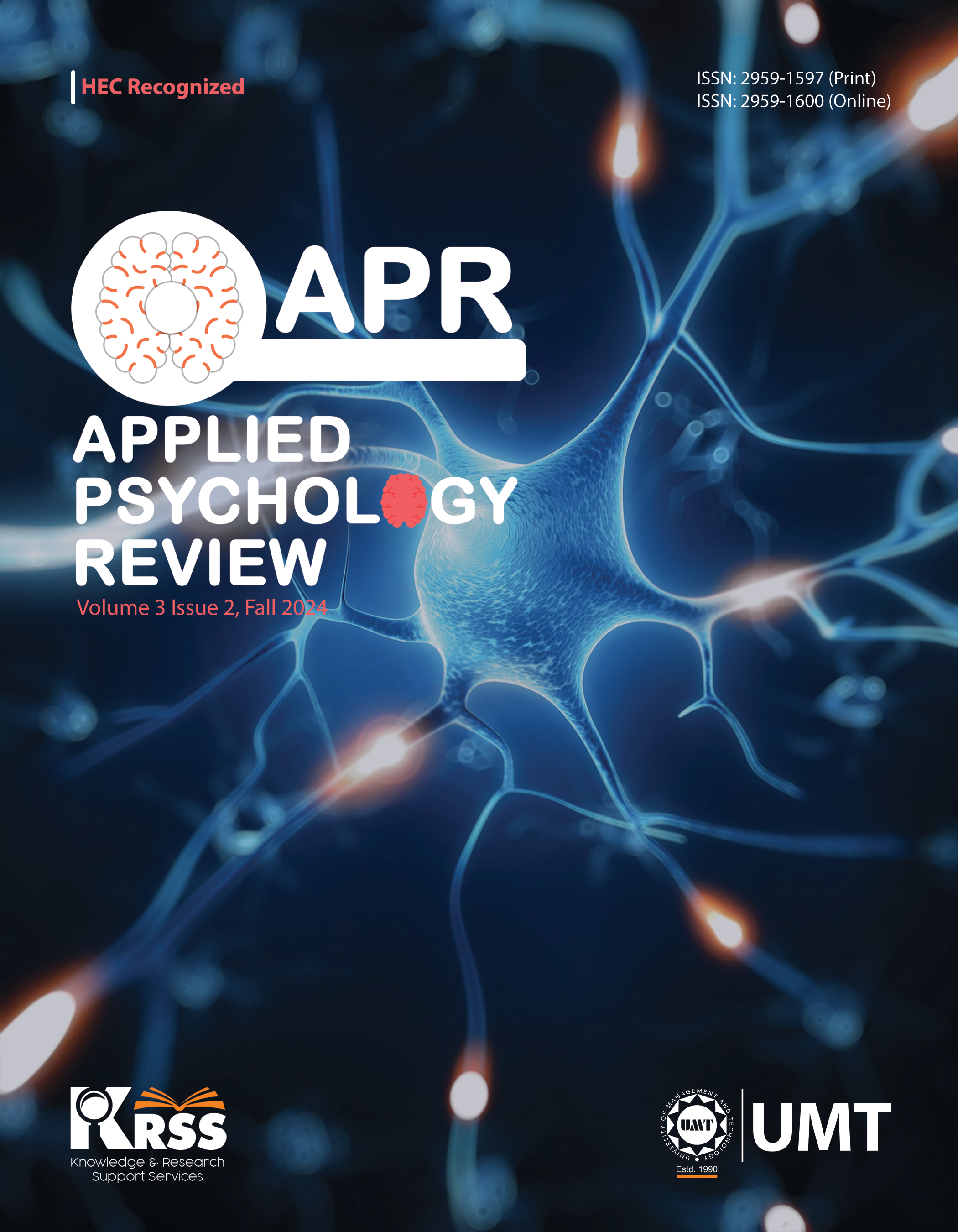Attachment Styles, Interpersonal Cognitive Distortions, and Loneliness among Undergraduate University Students in Karachi, Pakistan
Abstract
 Abstract Views: 0
Abstract Views: 0
Attachment styles signify an important aspect in interpersonal cognitive distortions which can influence social relationships and lead towards loneliness. The current study aimed to explore the relationship between attachment styles, interpersonal cognitive distortions, and loneliness among undergraduate university students in Karachi, Pakistan. A sample of 670 undergraduate university students (Male =294, Female =376) within the age range of 18 to 25 years (M=20.81, SD=1.63) completed the survey. Revised Adult Attachment Scale (RAAS), Interpersonal Cognitive Distortion Scale (ICDS), and UCLA Loneliness Scale (Revised Version 3) were used as tools to collect the required data. Afterwards, Statistical Package for Social Sciences (SPSS 26) was employed for data analysis. Significant correlations were found among attachment styles, interpersonal cognitive distortions, and loneliness. Furthermore, male students reported to have higher levels of interpersonal misperception (M =9.09, SD = 2.49) as compared to female students. The findings of the current research have implications for developing therapeutic interventions fostering healthy attachment styles to reduce interpersonal cognitive distortions and loneliness for better social integration.
Downloads
References
Arriaga, X. B., Kumashiro, M., Simpson, J. A., & Overall, N. C. (2018). Revising working models across time: Relationship situations that enhance attachment security. Personality and Social Psychology Review, 22(1), 71–96. https://doi.org/10.1177/1088868317705257
Awan, A. G., & Zia, A. (2015). Comparative analysis of public and private educational institutions: A case study of District Vehari-Pakistan. Journal of Education and Practice, 6(16), 122–130.
Aydın, A., & Akgün, B. M. (2022). Interpersonal cognitive distortions and family role performances in spouses during COVID‐19 pandemic process in Turkey. Perspectives in Psychiatric Care, 58(1), 189–196. https://doi.org/10.1111/ppc.12795
Bernardon, S., Babb, K. A., Hakim-Larson, J., & Gragg, M. (2011). Loneliness, attachment, and the perception and use of social support in university students. Canadian Journal of Behavioural Science, 43(1), 40–51. https://doi.org/10.1037/a0021199
Borawski, D., Sojda, M., Rychlewska, K., & Wajs, T. (2022). Attached but lonely: Emotional intelligence as a mediator and moderator between attachment styles and loneliness. International Journal of Environmental Research and Public Health, 19(22), Article e14831. https://doi.org/10.3390/ijerph192214831
Burns, A., Leavey, G., & O’Sullivan, R. (2022). Associations between parental bonding, social isolation and loneliness: Do associations persist in later life and is isolation a mediator between parental bonding and loneliness? BMC Psychology, 10, Article e152. https://doi.org/10.1186/s40359-022-00855-z
Çayir, G. A., & Kalkan, M. (2018). The effect of interpersonal dependency tendency on interpersonal cognitive distortions on youths. Journal of Human Behavior in the Social Environment, 28(6), 771–786. https://doi.org/10.1080/10911359.2018.1458681
Christiansen, J., Qualter, P., Friis, K., Pedersen, S., Lund, R., Andersen, C., Bekker-Jeppesen, M., & Lasgaard, M. (2021). Associations of loneliness and social isolation with physical and mental health among adolescents and young adults. Perspectives in Public Health, 141(4), 226–236. https://doi.org/10.1177/17579139211016077
Collins, N. L., & Read, S. J. (1990). Adult attachment, working models, and relationship quality in dating couples. Journal of Personality and Social Psychology, 58(4), 644–663. https://doi.org/10.1037/0022-3514.58.4.644
Cook, S. I., Meyer, D., & Knowles, S. R. (2019). Relationships between psychoevolutionary fear of evaluation, cognitive distortions, and social anxiety symptoms: A preliminary structural equation model. Australian Journal of Psychology, 71(2), 92–99. https://doi.org/10.1111/ajpy.12215
D’Rozario, A. B., & Pilkington, P. D. (2022). Parental separation or divorce and adulthood attachment: The mediating role of the Abandonment schema. Clinical Psychology & Psychotherapy, 29(2), 664–675. https://doi.org/10.1002/cpp.2659
Hamamci, Z., & Büyüköztürk, Ş. (2004). The interpersonal cognitive distortions scale: Development and psychometric characteristics. Psychological Reports, 95(1), 291–303. https://doi.org/10.2466/pr0.95.1.291-303
Hazan, C., & Shaver, P. (1987). Romantic love conceptualized as an attachment process. Journal of Personality and Social Psychology, 52(3), 511–524. https://doi.org/10.1037/0022-3514.52.3.511
Helm, P. J., Jimenez, T., Bultmann, M., Lifshin, U., Greenberg, J., & Arndt, J. (2020). Existential isolation, loneliness, and attachment in young adults. Personality and Individual Differences, 159(109890), Article e109890. https://doi.org/10.1016/j.paid.2020.109890
Horgan, A., Sweeney, J., Behan, L., & McCarthy, G. (2016). Depressive symptoms, college adjustment and peer support among undergraduate nursing and midwifery students. Journal of Advanced Nursing, 72(12), 3081–3092. https://doi.org/10.1111/jan.13074
Karim, S., Saeed, K., Rana, M. H., Mubbashar, M. H., & Jenkins, R. (2004). Pakistan mental health country profile. International Review of Psychiatry, 16(1–2), 83–92. https://doi.org/10.1080/09540260310001635131
Leary, M. R. (2015). Emotional responses to interpersonal rejection. Dialogues in clinical neuroscience, 17(4), 435–441. https://doi.org/10.31887/DCNS.2015.17.4/mleary
Lin, Y., & Fan, Z. (2023). The relationship between rejection sensitivity and social anxiety among Chinese college students: The mediating roles of loneliness and self-esteem. Current Psychology, 42(15), 12439–12448. https://doi.org/10.1007/s12144-021-02443-7
Mathew, A. G., & Simon, S. (2024). Peer pressure, academic stress and self-regulation among college students. International Journal for Multidisciplinary Research, 6(2), 1–9. https://doi.org/10.36948/ijfmr.2024.v06i02.16930
Matturro, L. (2019). Stress, cognitive distortions, engagement in self-care, and burnout in psychology graduate students [Doctoral dissertation, Philadelphia College of Osteopathic Medicine]. DigitalCommons@PCOM. https://digitalcommons.pcom.edu/psychology_dissertations/506/
Maurya, A. K., Sharma, P., & Asthana, H. S. (2016, March 1–2). Role of gender in cognitive distortions and depression among adolescents [Paper presentation]. International Conference on Psychosocial Perspectives on Health and Well-being. New Delhi, India.
Mberia, A., & Midigo, R. (2018). Understanding career choice dilemma in Kenya: Issues of informed choices and course availability. Journal of Education and Practice, 9(9), 35–42.
Ramón-Arbués, E., Gea-Caballero, V., Granada-López, J. M., Juárez-Vela, R., Pellicer-García, B., & Antón-Solanas, I. (2020). The prevalence of depression, anxiety and stress and their associated factors in college students. International Journal of Environmental Research and Public Health/International Journal of Environmental Research and Public Health, 17(19), Article e7001. https://doi.org/10.3390/ijerph17197001
Reis, M., & De Matos, M. G. (2019). Worries, mental and emotional health difficulties of Portuguese university students. Advances in Social Sciences Research Journal, 6(7), 558–569. https://doi.org/10.14738/assrj.67.6818
Rogers, A. A., Nielson, M. G., & Santos, C. E. (2021). Manning up while growing up: A developmental-contextual perspective on masculine gender-role socialization in adolescence. Psychology of Men & Masculinities, 22(2), Article e354. https://doi.org/10.1037/men0000296
Russell, D. W. (1996). UCLA loneliness scale (Version 3): Reliability, validity, and factor structure. Journal of Personality Assessment, 66(1), 20–40. https://doi.org/10.1207/s15327752jpa6601_2
Seiffge-Krenke, I. (2020). Parenting adolescents in an increasingly diverse world: links to adolescents’ psychopathology. Psychology, 11(6), 874–887. https://doi.org/10.4236/psych.2020.116057
Şimşek, O. M., Koçak, O., & Younis, M. Z. (2021). The impact of interpersonal cognitive distortions on satisfaction with life and the mediating role of loneliness. Sustainability, 13(16), Article e9293. https://doi.org/10.3390/su13169293
Spithoven, A. W., Bijttebier, P., & Goossens, L. (2017). It is all in their mind: A review on information processing bias in lonely individuals. Clinical Psychology Review, 58, 97–114. https://doi.org/10.1016/j.cpr.2017.10.003
Taheri, A., Javidi, H., Bagholi, H., & Firoozabadi, A. (2022). The mediating role of cognitive emotion regulation and cognitive distortion strategies in relation to attachment styles and dissociative experiences. Journal of Basic Research in Medical Sciences, 9(1), 31–39.
Waters, L., Algoe, S. B., Dutton, J., Emmons, R., Fredrickson, B. L., Heaphy, E., Moskowitz, J. T., Neff, K., Niemiec, R., Pury, C., & Steger, M. (2021). Positive psychology in a pandemic: buffering, bolstering, and building mental health. The Journal of Positive Psychology, 17(3), 303–323. https://doi.org/10.1080/17439760.2021.1871945
Wei, M., Russell, D. W., & Zakalik, R. A. (2005). Adult Attachment, Social Self-Efficacy, Self-Disclosure, Loneliness, and Subsequent Depression for Freshman College Students: A Longitudinal Study. Journal of Counseling Psychology, 52(4), 602–614. https://doi.org/10.1037/0022-0167.52.4.602
Zaiden, F., & Mahfar, M. (2022). Needs analysis of depression and cognitive distortion module among out-of-wedlock pregnant adolescents. Sains Humanika, 14(2), 79–86. https://doi.org/10.11113/sh.v14n2.1847
Zhang, W., Qiu, L., Tang, F., & Sun, H. J. (2023). Gender differences in cognitive and affective interpersonal emotion regulation in couples: An fNIRS hyperscanning. Social Cognitive and Affective Neuroscience, 18(1), ensad057. https://doi.org/10.1093/scan/nsad057
Copyright (c) 2024 Tayyaba Anwar, Mariam Saleem, Suad Yaseen, Mahum Azhaar

This work is licensed under a Creative Commons Attribution 4.0 International License.




